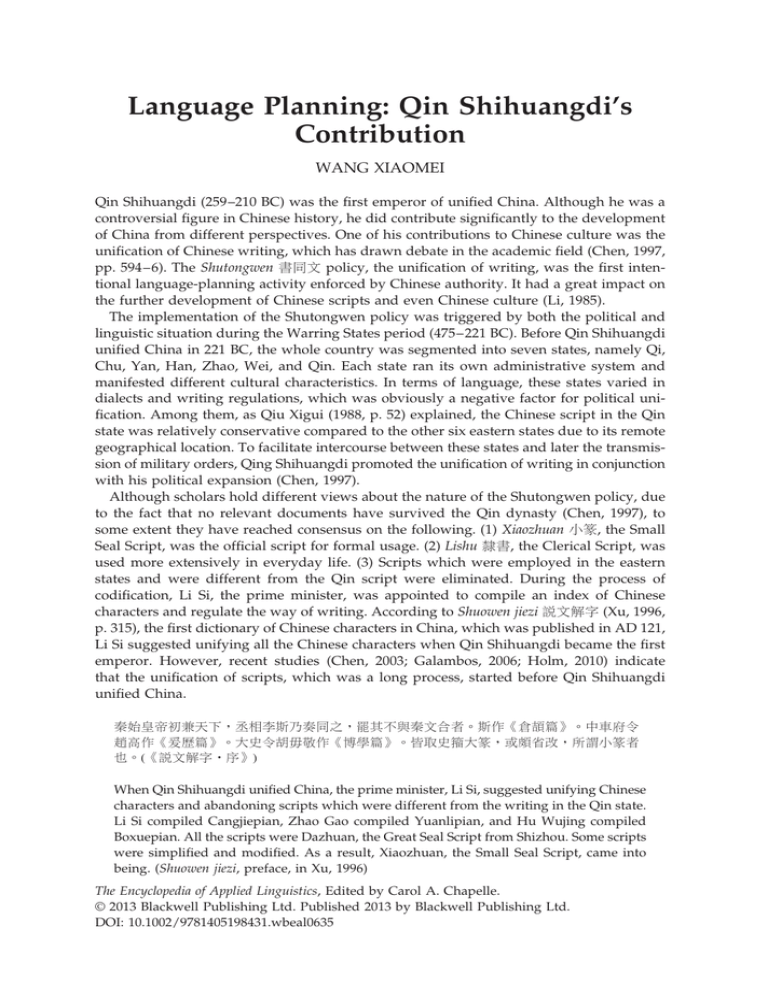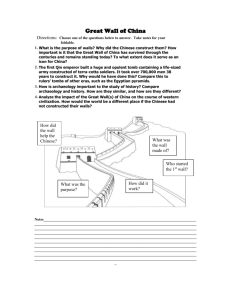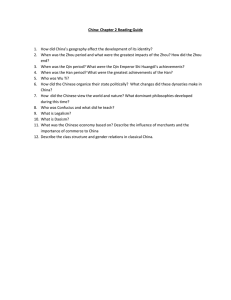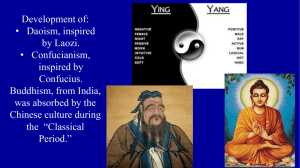"Language Planning: Qin Shihuangdi`s Contribution" In: The
advertisement

Language Planning: Qin Shihuangdi’s Contribution WANG XIAOMEI Qin Shihuangdi (259–210 BC) was the first emperor of unified China. Although he was a controversial figure in Chinese history, he did contribute significantly to the development of China from different perspectives. One of his contributions to Chinese culture was the unification of Chinese writing, which has drawn debate in the academic field (Chen, 1997, pp. 594–6). The Shutongwen !"# policy, the unification of writing, was the first intentional language-planning activity enforced by Chinese authority. It had a great impact on the further development of Chinese scripts and even Chinese culture (Li, 1985). The implementation of the Shutongwen policy was triggered by both the political and linguistic situation during the Warring States period (475–221 BC). Before Qin Shihuangdi unified China in 221 BC, the whole country was segmented into seven states, namely Qi, Chu, Yan, Han, Zhao, Wei, and Qin. Each state ran its own administrative system and manifested different cultural characteristics. In terms of language, these states varied in dialects and writing regulations, which was obviously a negative factor for political unification. Among them, as Qiu Xigui (1988, p. 52) explained, the Chinese script in the Qin state was relatively conservative compared to the other six eastern states due to its remote geographical location. To facilitate intercourse between these states and later the transmission of military orders, Qing Shihuangdi promoted the unification of writing in conjunction with his political expansion (Chen, 1997). Although scholars hold different views about the nature of the Shutongwen policy, due to the fact that no relevant documents have survived the Qin dynasty (Chen, 1997), to some extent they have reached consensus on the following. (1) Xiaozhuan $%, the Small Seal Script, was the official script for formal usage. (2) Lishu &!, the Clerical Script, was used more extensively in everyday life. (3) Scripts which were employed in the eastern states and were different from the Qin script were eliminated. During the process of codification, Li Si, the prime minister, was appointed to compile an index of Chinese characters and regulate the way of writing. According to Shuowen jiezi '#() (Xu, 1996, p. 315), the first dictionary of Chinese characters in China, which was published in AD 121, Li Si suggested unifying all the Chinese characters when Qin Shihuangdi became the first emperor. However, recent studies (Chen, 2003; Galambos, 2006; Holm, 2010) indicate that the unification of scripts, which was a long process, started before Qin Shihuangdi unified China. *+,-./012345678"92:;<=*#>?@6ABCDEF@GHIJ KLABMNEF@OPJQRSABTUEF@VWPXO%2YZ[\2]^$%? _@`B'#()abFc When Qin Shihuangdi unified China, the prime minister, Li Si, suggested unifying Chinese characters and abandoning scripts which were different from the writing in the Qin state. Li Si compiled Cangjiepian, Zhao Gao compiled Yuanlipian, and Hu Wujing compiled Boxuepian. All the scripts were Dazhuan, the Great Seal Script from Shizhou. Some scripts were simplified and modified. As a result, Xiaozhuan, the Small Seal Script, came into being. (Shuowen jiezi, preface, in Xu, 1996) The Encyclopedia of Applied Linguistics, Edited by Carol A. Chapelle. © 2013 Blackwell Publishing Ltd. Published 2013 by Blackwell Publishing Ltd. DOI: 10.1002/9781405198431.wbeal0635 2 language planning: qin shihuangdi ’ s contribution In light of the theory of language planning, codification is a crucial procedure for corpus planning (Haugen, 1966), which focuses on the language itself, such as orthography, compilation of dictionaries, reform of writing systems, and so on (Kloss, 1969). In a society, the prestige code which carries greater importance and enjoys a higher status will be chosen. The Small Seal Script, Xiaozhuan $%, which is based on Dazhuan O%, the Great Seal Script, according to Xu Shen, was used as the official script in the Qin Dynasty. However, Qiu Xigui (1988, p. 65) holds a different opinion. Qiu contends that the characters used in the Qin state from the Spring and Autumn Period had evolved gradually into the Small Seal Script (Qiu, 1988, p. 65). No matter how scholars interpret the term “Xiaozhuan” and its origin, they all agree that the official script promoted by Qin Shihuangdi is Xiaozhuan. As part of corpus planning, Li Si, Zhao Gao, and Hu Wujing compiled three textbooks, which are known as Sancang dC, containing 55 chapters with 60 characters in each chapter (Bodde, 1967, p. 150). These textbooks are the fundamental teaching materials in which standard Chinese characters in Xiaozhuan are provided. With strong promotion and strict regulation, Xiaozhuan was introduced all over the country. It was used in all formal domains as the standard form ef), such as inscriptions, school textbooks, and so on. In the meantime, Lishu &!, the Clerical Script, was extensively used by the populace due to its simplified structure and straight strokes, which gradually developed into the standard script in the succeeding Han Dynasty. As a matter of fact, the use of Lishu is one of the contributions of Qin Shihuangdi (Li, 1985). To summarize, Qin Shihuangdi was the first person in China who planned the Chinese script consciously to meet the needs of unification and communication among the people. What he did can be analyzed in the framework proposed by Haugen (1966), who divided language planning into four stages, namely norm selection, codification, implementation, and elaboration. Norm selection falls into the category of status planning since it promotes a prestige norm; the other three stages are regarded as corpus planning since they are related to the language itself. By selecting Xiaozhuan as a unifying script for the whole country, Qin Shihuangdi found a way to unite people with diverse dialectal backgrounds. This tradition was passed on dynasty after dynasty. In this sense, Qin Shihuangdi established a tradition of using a unified script which is hyper-dialect and hyper-region. Although Chinese script has evolved several times in the history of China, its function as a bridging form across geographical regions has never changed. The policy of Shutongwen !"# by Qin Shihuangdi is indeed a great contribution to Chinese culture (Guo, 1972). SEE ALSO: Language Planning and Multilingualism; Prestige Planning; Status Planning References Bodde, D. (1967). The unification of writing. In D. Bodde, China’s first unifier (pp. 147–61). Aberdeen, Hong Kong: Hong Kong University Press. Chen, C. J. (1997). Qin Shutongwenzi xin tan. Bulletin of the Institute of History and Philology, 68(3), 589–641. Chen, C. J. (2003). Qinxi wenzi yanjiu. Taipei, Taiwan/Republic of China: Institute of History and Philology, Academia Sinica. Galambos, I. (2006). Orthography of early Chinese writing: Evidence from newly excavated manuscripts. Budapest, Hungary: Department of East Asian Studies, Eötvös Loránd University. Guo, M. R. (1972). Gudai wenzi zhi bianzheng de fazhan. Journal of Archaeology, 3, 2–13. Haugen, E. M. (1966). Linguistics and language planning. In W. Bright (Ed.), Sociolinguistics (pp. 50–71). The Hague, Netherlands: De Gruyter. Holm, D. (2010). Some variant characters in a traditional Zhuang manuscript: A new angle on the Chinese script. Bulletin of the Museum of Far Eastern Antiquities, 78, 125–72. language planning: qin shihuangdi ’ s contribution 3 Kloss, H. (1969). Research possibilities on group bilingualism: A report. Quebec, Canada: International Center for Research on Bilingualism. Li, X. Q. (1985). Eastern Zhou and Qin civilizations. New Haven, CT: Yale University Press. Qiu, X. G. (1988). Wenzixue gaiyao. Beijing, China: Shangwu yinshuguan. Xu, S. (1996). Shuowen jiezi. Beijing, China: Zhonghua shuju. Suggested Readings Barnard, N. (1978). The nature of the Ch’in “Reform of the Script” as reflected in archaeological documents excavated under conditions of control. In D. T. Roy and T. H. Tsien (Eds.), Ancient China: Studies in early civilization, (pp. 181–213). Shatin, Hong Kong: Chinese University Press. Boltz, W. G. (1994). The origin and early development of the Chinese writing system. New Haven, CT: American Oriental Society. Tang, L. (1963). Zhongguo wenzixue. Hong Kong: Taiping shuju.






